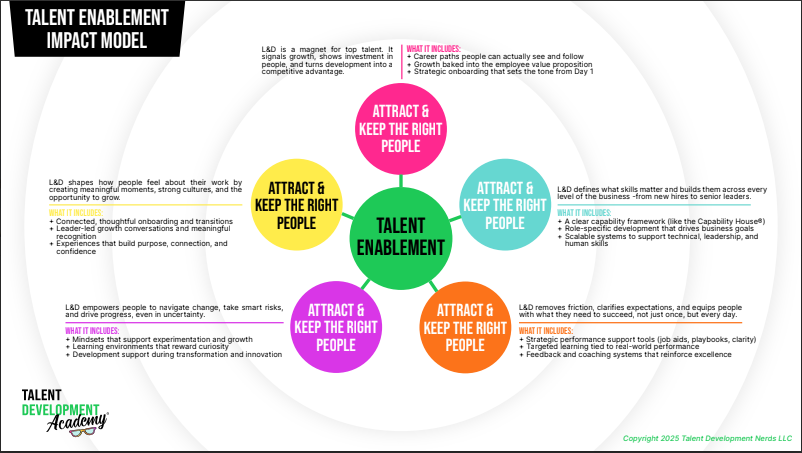And Why It’s Time to Stop Saying “I Train People”
If you work in Learning & Development (L&D), you’ve probably said this at least once:
“I train people.”
It feels simple. Harmless. Accurate enough.
But it’s also the reason so many L&D professionals are misunderstood, undervalued, and underused.
Saying “I train people” is like a Michelin-star chef saying they make toast.
Technically true. But wildly underselling the magic.
And if we keep shrinking our work down to something that fits neatly into a checkbox, we shouldn’t be surprised when others do the same.
So in this post, we’re going to break that cycle.
We’ll explore:
- What L&D professionals actually do
- Why “training” barely scratches the surface
- How to explain your work in a way that builds credibility
- The real business impact of strategic L&D
- And the future of this field: Talent Enablement
Let’s get into it.
What Most People Think L&D Does (And Why It’s a Problem)
We’ve all been there:
You’re in a meeting or chatting with someone new and they say,
“So, what do you do?”
And your answer is something like:
- “I run onboarding.”
- “I build learning content.”
- “I train employees.”
And immediately, your role is mentally filed under “support function.” Helpful, but not critical. Optional. Replaceable.
Every time we introduce ourselves like this, we unintentionally downplay our own impact.
Because here’s what L&D actually does:
We solve real business problems.
We build strategic capabilities.
We keep great people engaged and growing.
We help leaders actually lead.
We enable the entire organization to stay competitive.
And we do all of this through a blend of systems thinking, psychology, change, performance, and learning science.
That’s not training. That’s transformation.
How L&D Has Evolved: From Training to Talent Enablement
Historically, L&D was reactive.
Someone needed to know something → we delivered a training session.
Simple. But no longer enough.
Work today is messy. Fast. Complex. Cross-functional.
We can’t just respond, we need to enable.
That’s why I use the term Talent Enablement.
Talent Enablement is about aligning learning, leadership, performance, and culture to drive business success through people.
It’s not just “teaching skills.”
It’s removing friction.
It’s improving systems.
It’s coaching, consulting, advising, building, fixing, aligning.
It’s being the team that helps every other team perform better.
What L&D Professionals Really Do
Here’s what your job actually looks like when you step into strategic L&D leadership:
🎯 Strategic Alignment
You connect learning to business outcomes. You ask “What’s the goal?” before you build anything.
🧠 Performance Consulting
You don’t take every training request at face value. You diagnose the root cause and solve the real problem.
🧱 Capability Building
You define what “great” looks like across roles and levels, and you help people grow into it.
⚙️ Operational Design
You implement systems and tech that support learning, not just store it.
🚀 Culture + Change
You help people adapt, grow, and stay engaged in the face of nonstop change.
If you’re doing this work, say it. Own it.
You’re not “just training people.”
You’re enabling performance.
Show the Business Impact: The 5-Spoke Model
Still struggling to articulate your value?
Here’s a simple framework to guide the conversation:
The 5-Spoke Talent Enablement Model helps L&D teams demonstrate their business-critical role.
- Attract + Retain Talent
Development is the #1 reason people stay. You make that real. - Build Capability
You don’t guess, you define and grow the skills that matter most. - Drive High Performance
You remove confusion. You bring clarity, tools, training, and coaching. - Fuel Innovation + Agility
You create environments where people can think, try, fail, and improve. - Elevate the Employee Experience
From day one to exit, you shape how people feel about work.

Want the visual?
📥 Download the 5-Spoke Impact Model and the Infinity Loop
How to Talk About Your Work (Without Sounding Like a Buzzword Machine)
Here are a few simple language swaps to position your work with clarity and confidence:
❌ “I build training.”
✅ “I design solutions that help people do their best work.”
❌ “I manage the LMS.”
✅ “I run systems that make learning seamless and scalable.”
❌ “I develop learning content.”
✅ “I enable the business to build capability at scale.”
And when you’re in a leadership conversation?
“My work helps you keep your best people, build strategic skills, and ensure the team can actually deliver on your goals.”
That’s not fluff. That’s business.
One More Thing…
If this post sparked something, if you finally feel like someone’s saying what you’ve been trying to explain for years, then this is your sign to step into it.
Not just the work, but the language, the presence, the leadership it takes to own your role in shaping the future of work.
And if you want frameworks, templates, coaching, and a community that’s doing exactly that?
🎓 Come join us inside the Talent Development Academy
You’ll go from:
“I do training” → “I lead strategic talent development in my organization.”
From stuck → strategic.
From support → business partner.
You were never “just training people.”
Now it’s time to help everyone else see it too.
Research:
McKinsey: The essential components of a successful L&D Strategy
Josh Bersin: Are you ready for the reinvention of Learning and Development?
Hi there, I'm Candice Mitchell!
Hi there,
I'm Candice Mitchell!
Meet the Author
I work with corporate clients carving out strategic Talent Development plans. I’ve been where you are now, and not only have I put in all the hard work and made all the mistakes that finally enabled me to get to a place of progression and impact that we talk of, but I’ve placed it all together in a signature program, The Talent Development Academy®.
